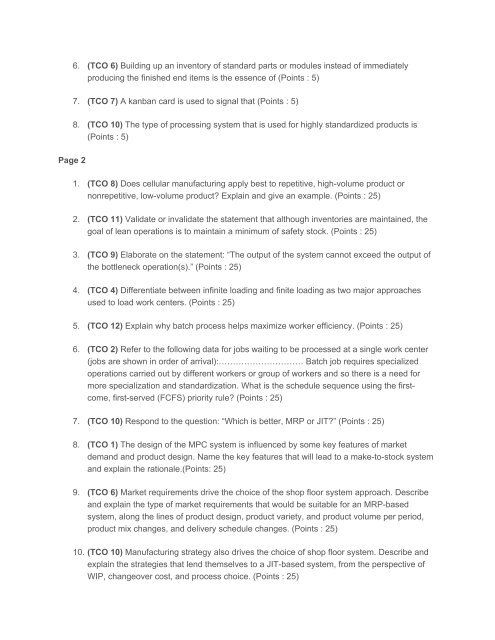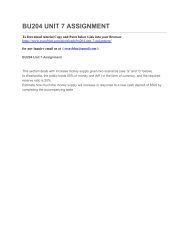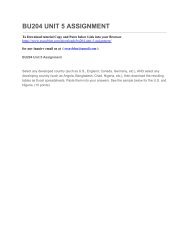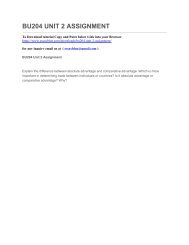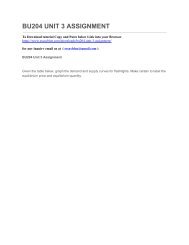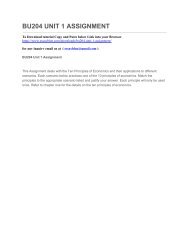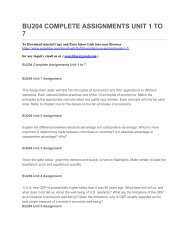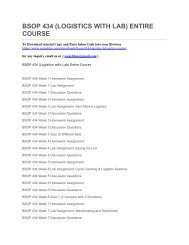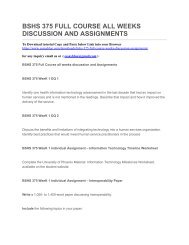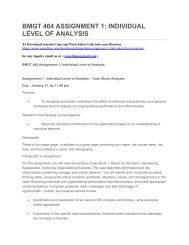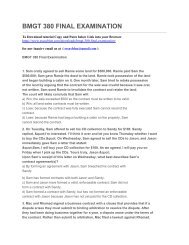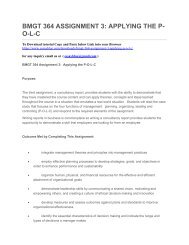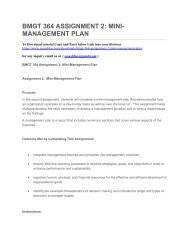BSOP 429 PRODUCTION ACTIVITY CONTROL AND JUST-IN-TIME WITH LAB – FULL COURSE
Create successful ePaper yourself
Turn your PDF publications into a flip-book with our unique Google optimized e-Paper software.
6. (TCO 6) Building up an inventory of standard parts or modules instead of immediately<br />
producing the finished end items is the essence of (Points : 5)<br />
7. (TCO 7) A kanban card is used to signal that (Points : 5)<br />
8. (TCO 10) The type of processing system that is used for highly standardized products is<br />
(Points : 5)<br />
Page 2<br />
1. (TCO 8) Does cellular manufacturing apply best to repetitive, high-volume product or<br />
nonrepetitive, low-volume product? Explain and give an example. (Points : 25)<br />
2. (TCO 11) Validate or invalidate the statement that although inventories are maintained, the<br />
goal of lean operations is to maintain a minimum of safety stock. (Points : 25)<br />
3. (TCO 9) Elaborate on the statement: “The output of the system cannot exceed the output of<br />
the bottleneck operation(s).” (Points : 25)<br />
4. (TCO 4) Differentiate between infinite loading and finite loading as two major approaches<br />
used to load work centers. (Points : 25)<br />
5. (TCO 12) Explain why batch process helps maximize worker efficiency. (Points : 25)<br />
6. (TCO 2) Refer to the following data for jobs waiting to be processed at a single work center<br />
(jobs are shown in order of arrival):………………………… Batch job requires specialized<br />
operations carried out by different workers or group of workers and so there is a need for<br />
more specialization and standardization. What is the schedule sequence using the firstcome,<br />
first-served (FCFS) priority rule? (Points : 25)<br />
7. (TCO 10) Respond to the question: “Which is better, MRP or JIT?” (Points : 25)<br />
8. (TCO 1) The design of the MPC system is influenced by some key features of market<br />
demand and product design. Name the key features that will lead to a make-to-stock system<br />
and explain the rationale.(Points: 25)<br />
9. (TCO 6) Market requirements drive the choice of the shop floor system approach. Describe<br />
and explain the type of market requirements that would be suitable for an MRP-based<br />
system, along the lines of product design, product variety, and product volume per period,<br />
product mix changes, and delivery schedule changes. (Points : 25)<br />
10. (TCO 10) Manufacturing strategy also drives the choice of shop floor system. Describe and<br />
explain the strategies that lend themselves to a JIT-based system, from the perspective of<br />
WIP, changeover cost, and process choice. (Points : 25)


